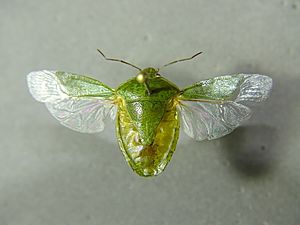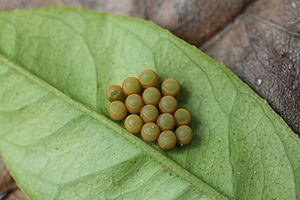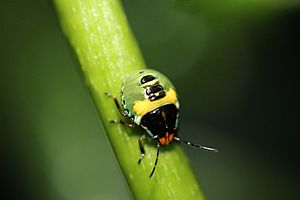Australasian green shield bug facts for kids
Quick facts for kids Australasian green shield bug |
|
|---|---|
 |
|
| Scientific classification | |
| Genus: |
Glaucias
|
| Species: |
amyoti
|
| Synonyms | |
|
Rhaphigaster amyoti Dallas, 1851 |
|
The Glaucias amyoti, also known as the Australasian green shield bug or New Zealand vegetable bug, is a type of shield bug. These interesting insects are found in several places, including Australia, New Zealand, Timor, and New Guinea.
Contents
What is a Shield Bug?
Shield bugs get their name from their unique body shape. Their backs are often flat and wide, looking a bit like a shield. This shape helps them blend in with leaves and branches. They belong to a group of insects called true bugs.
Where Do They Live?
These bugs are common in warmer climates. You can find them in gardens and natural areas across Australia, New Zealand, and nearby islands. They prefer places where their favorite food plants grow.
What Do They Eat?
Both young shield bugs (called nymphs) and adult bugs feed on plants. They have a special mouthpart that works like a straw. They use it to suck juices from different parts of plants.
Favorite Plants
Some of their favorite plants include certain types of Coprosma, Griselinia, and Myoporum species. By feeding on these plants, they get all the nutrients they need to grow and stay healthy.
Life Cycle of the Green Shield Bug
Like many insects, the Australasian green shield bug goes through different stages as it grows.
Eggs
Female shield bugs lay their eggs in small clusters, often on the underside of leaves. These eggs are usually tiny and can be hard to spot.
Nymphs
Once the eggs hatch, tiny young bugs called nymphs emerge. These nymphs look like smaller versions of the adult bugs but don't have fully developed wings. They shed their skin several times as they grow, a process called molting. Each time they molt, they get a little bigger and look more like an adult.
Adults
After several molts, the nymphs become adult shield bugs. The adults have fully formed wings and are ready to mate and lay their own eggs, continuing the life cycle.




